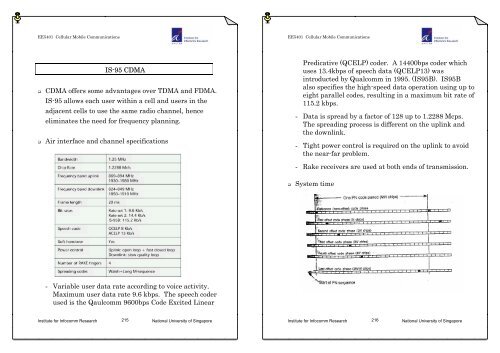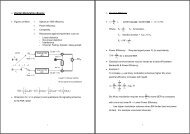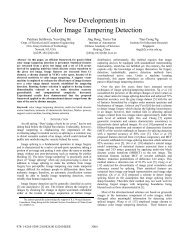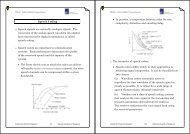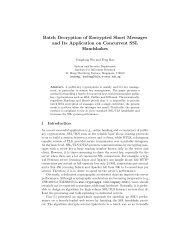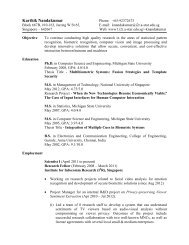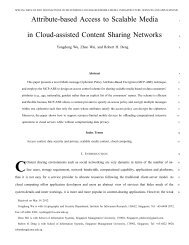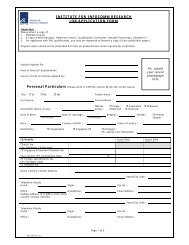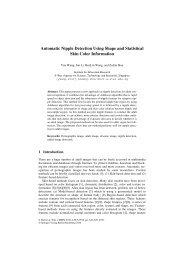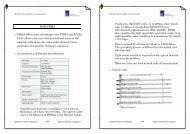IS-95 CDMA CDMA offers some advantages over TDMA and FDMA ...
IS-95 CDMA CDMA offers some advantages over TDMA and FDMA ...
IS-95 CDMA CDMA offers some advantages over TDMA and FDMA ...
You also want an ePaper? Increase the reach of your titles
YUMPU automatically turns print PDFs into web optimized ePapers that Google loves.
EE5401 Cellular Mobile CommunicationsEE5401 Cellular Mobile Communications<strong>IS</strong>-<strong>95</strong> <strong>CDMA</strong><strong>CDMA</strong> <strong>offers</strong> <strong>some</strong> <strong>advantages</strong> <strong>over</strong> <strong>TDMA</strong> <strong>and</strong> <strong>FDMA</strong>.<strong>IS</strong>-<strong>95</strong> allows each user within a cell <strong>and</strong> users in theadjacent cells to use the same radio channel, henceeliminates the need for frequency planning.Air interface <strong>and</strong> channel specificationsPredicative (QCELP) coder. A 14400bps coder whichuses 13.4kbps of speech data (QCELP13) wasintroducted by Qualcomm in 19<strong>95</strong>. (<strong>IS</strong><strong>95</strong>B). <strong>IS</strong><strong>95</strong>Balso specifies the high-speed data operation using up toeight parallel codes, resulting in a maximum bit rate of115.2 kbps.- Data is spread by a factor of 128 up to 1.2288 Mcps.The spreading process is different on the uplink <strong>and</strong>the downlink.- Tight power control is required on the uplink to avoidthe near-far problem.- Rake receivers are used at both ends of transmission.System time- Variable user data rate according to voice activity.Maximum user data rate 9.6 kbps. The speech coderused is the Qaulcomm 9600bps Code Excited LinearInstitute for Infocomm Research 215National University of SingaporeInstitute for Infocomm Research 216National University of Singapore
EE5401 Cellular Mobile CommunicationsEE5401 Cellular Mobile Communications- By using code offsets of 64 chips, unique spreadingsignature for 512 base stations are provided. (Whatdoes this impose on the cell size?)- An external reference signal such as GlobalPositioning System (GPS) is needed.Downlink/forward channelsEach radio or carrier channel contains up to sixty-fourlogical channels. Each logical channel is uniquelyidentified by a Walsh code.Downlink physical channel structure- Common channels : shared channel1. Pilot channel2. Paging channel3. Synchronization channel- Dedicated channels : allocated for the use of a singleuser4. Traffic channel- one pilot channel (W0)- one synchronisation channel (W32)- 0-7 paging channels- 0-62 traffic channelsWalsh codeH 1 = 0 ,0 0H 2 = ,0 1Institute for Infocomm Research 217National University of SingaporeInstitute for Infocomm Research 218National University of Singapore
EE5401 Cellular Mobile CommunicationsEE5401 Cellular Mobile Communications0H02 H2H4 = =H2H200010100110110, hence H 8 , H 16, H32H 64Pilot channel: for an omni-cell c<strong>over</strong>age, there is onlyone pilot per cell. For sectored cells, there is one pilotper sector.00010001H N H NH2 N ==H N H N 00010001000111100001111000010001111011100001111011100001- The pilot channel is an unmodulated carrier whichcontains no information.- A MS uses the pilot channel for phase reference forcoherent demodulation, timing acquisition, signalstrength comparison for h<strong>and</strong><strong>over</strong>s, power controlmeasurements.- In order to obtain a reliable phase reference forcoherent demodulation, the pilot channel istransmitted with higher power than the trafficchannels. Typically about 20% of the radiated poweron the downlink is dedicated to pilot signal.Sychronization channel : one per cell or one per sector.- A low powered, low rate (1200bps) which containssynchronization messages which are continuouslybroadcast by the cell or sector.- The channel is not scrambled <strong>and</strong> does not have apower-control subchannel. It is primarily used toacquire the system time <strong>and</strong> the long code. Longspreading code is unique to specific user.Institute for Infocomm Research 219National University of SingaporeInstitute for Infocomm Research 220National University of Singapore
EE5401 Cellular Mobile CommunicationsEE5401 Cellular Mobile Communications Paging channel :- It is used to1. Broadcast control information to all the mobileswithin the cell or sector c<strong>over</strong>age area.2. Transmit directed messages to a specific mobile or agroup of mobiles within the cell or sector c<strong>over</strong>agearea.- For a given cell or sector, the Paging channel data rateis either full rate (9600bps) or half rate (4800bps).vocoder output is half rate (4800bps); when speech iseven less active, transmission drops to quarter rate(2400bps). When the user is listening, transmission ofthe background sound is made at eighth rate (1200bps).- The Forward Traffic Channel has a power controlsubchannel. This power control subchannel containspower control bits used by the mobile station to adjustits transmit power level in the reverse direction. Thistechnique is referred to as closed loop power control.Forward link summary- Walsh code #1 is reserved for Paging Channel.- The Paging Channel is scrambled. It does not have apower-control subchannel.Forward traffic channel- Walsh codes #2-#31, #33-63 are reserved for ForwardTraffic Channel assignments. Each additional PagingChannel takes away one Traffic Channel Walsh code.- The Forward Traffic Channel is used to transmitPrimary Traffic or Secondary Traffic to a given MSduring a conversation or transaction. Primary Trafficrefers to Voice Traffic <strong>and</strong> Secondary Traffic refers toSignaling Traffic or Data Transaction.- When speed is active, the variable-rate vocoder outputis full rate (9600bps); when speech is less active, the- After obtaining phase <strong>and</strong> code synchronization, themobile station acquires synchronization information(data rate of the paging channel, time of the basestation′s pilot PN sequence with respect to the systemtime) from the synchronization channel.- Data to be transmitted on synchronization, paging <strong>and</strong>traffic channels are first grouped into 20ms frames,convolutionally encoded, repeated to adjust the datarate, <strong>and</strong> interleaved. Then the signal is spread withan orthogonal Walsh code at a rate of 1.2288 Mc/s,split into the I <strong>and</strong> Q channels, <strong>and</strong>, prior to baseb<strong>and</strong>filtering, spread with long PN sequences at a rate of1.2288 Mc/s.Institute for Infocomm Research 221National University of SingaporeInstitute for Infocomm Research 222National University of Singapore
EE5401 Cellular Mobile CommunicationsEE5401 Cellular Mobile Communications- Convolutional encoder <strong>and</strong> repetition circuit : a halfrateconvolution encoder with constraint length 9 isused. The encoding process is described by generatorvectors 753 (octal) <strong>and</strong> 561 (octal) respectively. Inorder to keep a constant baseb<strong>and</strong> symbol rate of19.2kbps, whenever the user rate is less than 9600bps,each symbol from the convolution encoder is repeated(till result in 19.2kbps) before block interleaving.- Block interleaver : After convolution coding <strong>and</strong>repetition, symbols are sent to a 20ms blockinterleaver which is a 24 x 16 array.- Long PN sequence : DS is used for data scrambling.This is to encrypt the signal on the paging <strong>and</strong> trafficchannels. The long PN sequence is uniquely assignedto each user. Each periodic long code with period 2 42 -1.The 1.2288 MHz PN sequence is applied to a decimator,which keeps only the first chip out of every sixty-fourconsecutive PN chips, so that the output symbol ratefrom the decimator is 19.2 kbps. (scrambling has to bedone at the modulation symbol rate to preserve Walshsequence orthogonality among users)- Orthogonal channelization : Each traffic channel (MS)transmitted on the forward <strong>CDMA</strong> channel is spreadwith a Walsh funcion at a fixed chip rate of 1.2288Mcps. The Walsh codes are completely orthogonal toeach other <strong>and</strong> provide orthogonal channelization forall users on the forward link.- Quadrature modulation : Symbols are spread inquadrature. A short binary spreading sequence with aperiod of 2 15 -1 chips, is used for easy acquisition <strong>and</strong>synchronization at each MS <strong>and</strong> is used for modulation.The short spreading sequence is called the pilot PNsequence. In-phase <strong>and</strong> quadrature PN codes are usedrespectively. QPSK modulation is used.- A pilot channel only consists of the quadrature PNspreading code.Institute for Infocomm Research 223National University of SingaporeInstitute for Infocomm Research 224National University of Singapore
EE5401 Cellular Mobile CommunicationsEE5401 Cellular Mobile CommunicationsInstitute for Infocomm Research 225National University of SingaporeInstitute for Infocomm Research 226National University of Singapore
EE5401 Cellular Mobile CommunicationsEE5401 Cellular Mobile CommunicationsWhile a user is tracking the pilot of a particular cell,it can be searching for pilots of adjacent cells (usingthe searching mechanism of its multipath rakereceiver). To make this simple <strong>and</strong> practical, all pilotPN sequences can use the same maximum lengthgenerator sequence, with different initial vectors <strong>and</strong>hence timing offsets.- Once a new pilot is detected by the searcher <strong>and</strong> foundto have sufficient signal strength (usually relative tothe first pilot already being tracked), the mobile willsignal this event to its original base station. This inturn will notify the switching centre, which enables thesecond cell′s base station to both send <strong>and</strong> receive thesame traffic to <strong>and</strong> from the given mobile. Thisprocess is called soft h<strong>and</strong><strong>over</strong>.- The rake receiver demodulates both cells′ transmissionin two fingers of the rake <strong>and</strong> combines themcoherently, with appropriate delay adjustments, justas is done for time separated multipath components.(In the reversed link, normally each base stationdemodulates <strong>and</strong> decodes independently <strong>and</strong> up to theswitching centre to arbitrate between the two basestations′ decoded frame).Institute for Infocomm Research 227National University of SingaporeInstitute for Infocomm Research 228National University of Singapore
EE5401 Cellular Mobile CommunicationsEE5401 Cellular Mobile CommunicationsUplink/Reversed channel Convolutional encoder <strong>and</strong> symbol repetition :Two types of <strong>CDMA</strong> channels: Access <strong>and</strong> Reversetraffic channel- The convolutional coder used in the reverse trafficchannel is rate 1/3 <strong>and</strong> constraint length 9. The threegenerator vectors are 557(octal), 663(octal) <strong>and</strong>771(octal) respectively.- Coded bits after the convolutional encoder are repeatedbefore interleaving when the data rate is less than9600bps. After repetition, the symbol rate out of thecoder is fixed at 28.8kbps.Access channels (AC)- It is used by the MS to initiate communication withthe base station <strong>and</strong> to respond to paging channelmessages. The access channel is a r<strong>and</strong>om accesschannel with each channel user uniquely identified bytheir long code.- May consist up to 32 AC per supported paging channelat fixed rate 4800bps.Reverse traffic channel : The speech or user data ratein the reverse channel may be sent at 9600, 4800,2400 or 1200 bps.- The use of 1/3 coding rate is used in order to get agreater tolerance for interference in the uplink. This isbecause :1. Reverse channel transmitted power is much less thanthe forward channel transmitted power.2. The mobile users are asynchronous with one another,which causes greater multiple access interferencethan on the synchronous link.Institute for Infocomm Research 229National University of SingaporeInstitute for Infocomm Research 230National University of Singapore
EE5401 Cellular Mobile CommunicationsEE5401 Cellular Mobile CommunicationsDS spreading- Each code channel in a traffic channel <strong>and</strong> each accesschannel are identified by a different phase of a pseduor<strong>and</strong>omM-sequence with a length of 2 42 -1.Block interleaving is performed. Code symbols arewritten into the matrix by columns <strong>and</strong> read out by rows.- In theory, every chip-offset could be used as a differentuser code. This is the result of autocorrelationproperties of PN sequences. For a practical separationof 64 chips between consecutive offsets, there are 2 36possible offset. However, these shifted versions of thelong PN code are not perfectly orthogonal multipath<strong>and</strong> soft-h<strong>and</strong><strong>over</strong> further reduce the number of usersthat can suitably share a single physical channel in thereverse link. Usually it is limited to 16-24 users.Orthogonal modulationVariable data rate transmission- A 64-ary orthogonal modulation is used for the reverse<strong>CDMA</strong> channel. One of the 64 possible Walshfunctions is transmitted for each group of six coded bits.Example : if the interleaved data sequence is 000010, thisrepresents decimal number 2. As a result, Walsh code #2(64 Walsh chips) will be transmitted.- Note that Walsh functions are used for differentpurposes on the forward <strong>and</strong> reverse channels. On theforward channel, Walsh functions are used forspreading to denote a particular user channel, while onthe reverse channel, Walsh functions are used for datamodulation.- Repeated bits are gated-off <strong>and</strong> are not transmitted.The data burst r<strong>and</strong>omizer generates a maskingpattern that masks out the redundant data producedby the repetition device.- The masking pattern is generated on a frame-by-framebasis <strong>and</strong> depends on the data rate of the frame beingtransmitted.- This is to reduce the average amount of reverse linkinterference <strong>and</strong> thereby increase user capacity.- Method to mask out the signal will not be mentioned.Institute for Infocomm Research 231National University of SingaporeInstitute for Infocomm Research 232National University of Singapore
EE5401 Cellular Mobile CommunicationsEE5401 Cellular Mobile Communications Quadrature modulation :- The in-phase <strong>and</strong> quadrature spreading is performedby the same pair of M-sequences as in the forward link.These pilot sequences are used for synchronizationpurpose.- Modulation is offset quadrature PSK (OQPSK). Thedata spread by of Q-pilot PN sequence is delay by halfa chip (406.901ns) with respect to the data spread bythe I pilot PN sequence. This delay is to improvespectral shaping <strong>and</strong> synchronization.CodingForward linkRate ½, constraintlength 9Reverse linkRate 1/3, constraintlength 9Interleaving 1 frame, 384 symbols 1 frame, 576 symbolsWalshmodulationLong PN codeRepeatedsymbolsDistinguishes aparticular userScrambles data,decimated to symbolrateAll symbol transmittedProvides 64-arymodulationModulation QPSK OQPSKDistinguishes users, noneed to change rateRepeated symbols gatedoffInstitute for Infocomm Research 233National University of SingaporeInstitute for Infocomm Research 234National University of Singapore
EE5401 Cellular Mobile CommunicationsEE5401 Cellular Mobile CommunicationsPower controlThree different power control mechanism- Uplink open loop power control- Uplink closed loop power control- Downlink slow power controlOpen loop power controlClosed loop power control- Adjusts the initial access channel transmission powerof the MS <strong>and</strong> compensates large abrupt variations inthe pathloss attenuation.- MS estimate the pathloss by measuring received signalstrength at the mobile. Parameters are initiallytransmitted on the synchronization channel. Theparameters are used to adjust the open-loop control fordifferent cell sizes <strong>and</strong> parameters.- Since uplink <strong>and</strong> downlink have a frequencyseparation of 20MHz, their fading processes are notstrongly correlated. Even though the average power isapproximately the same, the short term power isdifferent, therefore, the open loop power control cannotcompensate for the uplink fading.- The BS measures the received SIR <strong>over</strong> 1.25ms period(equivalent to 24 bits at 19.2 kpbs), compares that tothe target SIR, <strong>and</strong> decides whether the MStransmission power needs to be increase or decreased.The power control bits are transmitted on thedownlink traffic channel every 1.25ms (800 bps) bypuncturing the data symbols. The placement of apower control bit is r<strong>and</strong>omized within the 1.25mspower control group.Institute for Infocomm Research 235National University of SingaporeInstitute for Infocomm Research 236National University of Singapore
EE5401 Cellular Mobile CommunicationsEE5401 Cellular Mobile Communications- The BS periodically redces the transmitted powerto the MS. The MS measures the frame error ratio.When this exceeds a predefined limit, says 1%, theMS requests additional power from the BS.- This adjustment occurs every 15-20ms.- Since the power control comm<strong>and</strong>s are transmitteduncoded, their error ratio is fairly high, on the order of5%. However, since the loop is of delta modulationtype this is telorable.Downlink slow power control- The main purpose of the slow downlink powercontrol is to improve the performance of MSs at acell edge where the signal is weak <strong>and</strong> theinterfering base station signals are strong.Institute for Infocomm Research 237National University of SingaporeInstitute for Infocomm Research 238National University of Singapore


